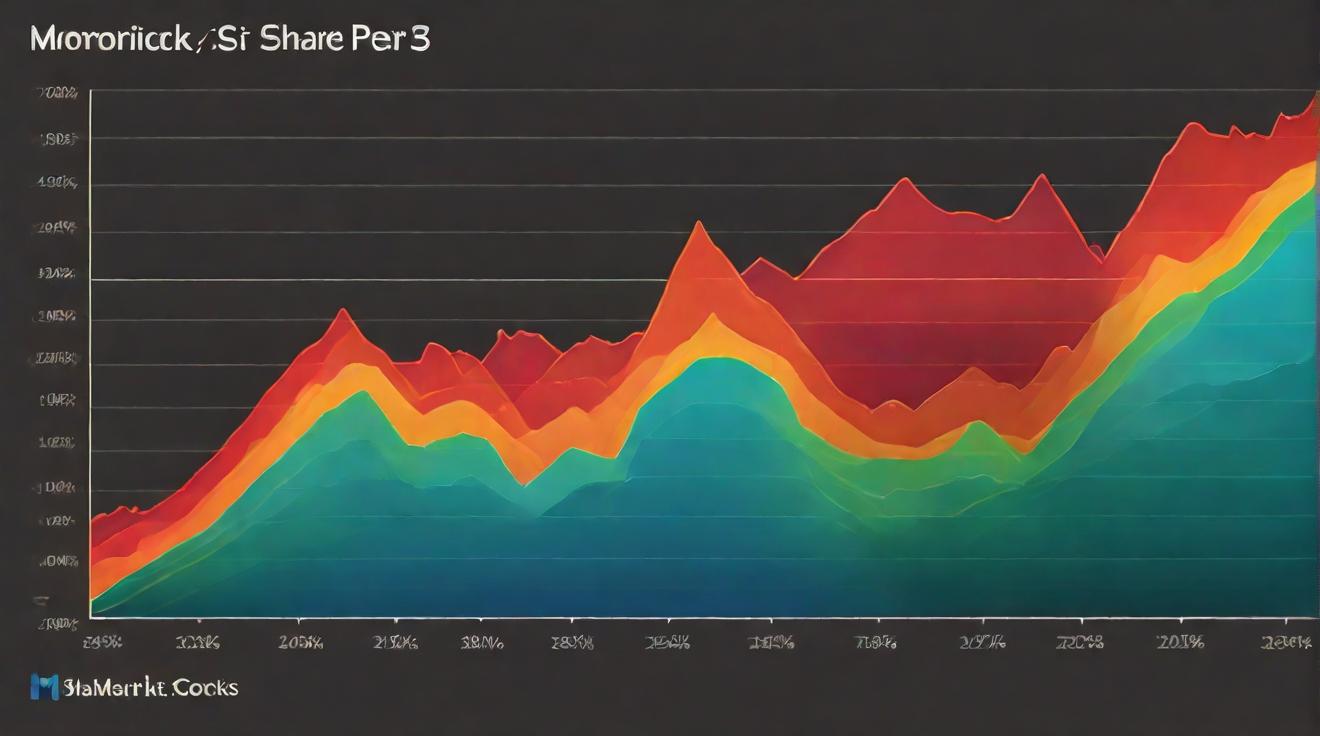Amazon’s launch of the Amazon Grocery brand represents a strategic push to capture a larger share of the budget grocery market, leveraging its scale and logistics capabilities to offer low-cost, quality products. This move intensifies competition in the grocery retail landscape, pressuring traditional grocers and retail chains. !-- wp:paragraph -->
- Opportunities: Expands Amazon’s grocery footprint; strengthens brand consolidation; attracts value-driven consumers; boosts online grocery sales and fresh food delivery.
- Risks: Potential margin pressure from low-price positioning; operational challenges in scaling fresh food delivery; increased competition may trigger price wars.
FinOracleAI — Market View
Amazon’s launch of the Amazon Grocery brand represents a strategic push to capture a larger share of the budget grocery market, leveraging its scale and logistics capabilities to offer low-cost, quality products. This move intensifies competition in the grocery retail landscape, pressuring traditional grocers and retail chains. !-- wp:paragraph -->- Opportunities: Expands Amazon’s grocery footprint; strengthens brand consolidation; attracts value-driven consumers; boosts online grocery sales and fresh food delivery.
- Risks: Potential margin pressure from low-price positioning; operational challenges in scaling fresh food delivery; increased competition may trigger price wars.
FinOracleAI — Market View
Amazon’s launch of the Amazon Grocery brand represents a strategic push to capture a larger share of the budget grocery market, leveraging its scale and logistics capabilities to offer low-cost, quality products. This move intensifies competition in the grocery retail landscape, pressuring traditional grocers and retail chains. !-- wp:paragraph -->- Opportunities: Expands Amazon’s grocery footprint; strengthens brand consolidation; attracts value-driven consumers; boosts online grocery sales and fresh food delivery.
- Risks: Potential margin pressure from low-price positioning; operational challenges in scaling fresh food delivery; increased competition may trigger price wars.
FinOracleAI — Market View
Amazon’s launch of the Amazon Grocery brand represents a strategic push to capture a larger share of the budget grocery market, leveraging its scale and logistics capabilities to offer low-cost, quality products. This move intensifies competition in the grocery retail landscape, pressuring traditional grocers and retail chains. !-- wp:paragraph -->- Opportunities: Expands Amazon’s grocery footprint; strengthens brand consolidation; attracts value-driven consumers; boosts online grocery sales and fresh food delivery.
- Risks: Potential margin pressure from low-price positioning; operational challenges in scaling fresh food delivery; increased competition may trigger price wars.
Strategic Context Amid Grocery Business Changes
Amazon’s grocery business has undergone significant adjustments recently. The company continues to reduce its footprint in physical stores, closing all Amazon Go cashierless convenience stores and Fresh supermarkets in the U.K. as part of this strategy. !-- wp:paragraph --> Concurrently, Amazon CEO Andy Jassy and other executives have highlighted growth in online sales of everyday essentials—including canned goods, paper products, and snacks—as a key driver of the grocery segment’s performance. !-- wp:paragraph --> To further expand its online grocery presence, Amazon has extended same-day delivery of fresh foods to additional U.S. markets, encouraging customers to add perishable items like meat and eggs to their orders. !-- wp:paragraph -->FinOracleAI — Market View
Amazon’s launch of the Amazon Grocery brand represents a strategic push to capture a larger share of the budget grocery market, leveraging its scale and logistics capabilities to offer low-cost, quality products. This move intensifies competition in the grocery retail landscape, pressuring traditional grocers and retail chains. !-- wp:paragraph -->- Opportunities: Expands Amazon’s grocery footprint; strengthens brand consolidation; attracts value-driven consumers; boosts online grocery sales and fresh food delivery.
- Risks: Potential margin pressure from low-price positioning; operational challenges in scaling fresh food delivery; increased competition may trigger price wars.
Strategic Context Amid Grocery Business Changes
Amazon’s grocery business has undergone significant adjustments recently. The company continues to reduce its footprint in physical stores, closing all Amazon Go cashierless convenience stores and Fresh supermarkets in the U.K. as part of this strategy. !-- wp:paragraph --> Concurrently, Amazon CEO Andy Jassy and other executives have highlighted growth in online sales of everyday essentials—including canned goods, paper products, and snacks—as a key driver of the grocery segment’s performance. !-- wp:paragraph --> To further expand its online grocery presence, Amazon has extended same-day delivery of fresh foods to additional U.S. markets, encouraging customers to add perishable items like meat and eggs to their orders. !-- wp:paragraph -->FinOracleAI — Market View
Amazon’s launch of the Amazon Grocery brand represents a strategic push to capture a larger share of the budget grocery market, leveraging its scale and logistics capabilities to offer low-cost, quality products. This move intensifies competition in the grocery retail landscape, pressuring traditional grocers and retail chains. !-- wp:paragraph -->- Opportunities: Expands Amazon’s grocery footprint; strengthens brand consolidation; attracts value-driven consumers; boosts online grocery sales and fresh food delivery.
- Risks: Potential margin pressure from low-price positioning; operational challenges in scaling fresh food delivery; increased competition may trigger price wars.
“During a time when consumers are particularly price-conscious, Amazon Grocery delivers more than 1,000 quality grocery items across all categories that don’t compromise on quality or taste – from fresh food items to crave-worthy snacks and pantry essentials – all at low, competitive prices that help customers stretch their grocery budgets further,” said Jason Buechel, Amazon’s vice president of worldwide grocery.
Market Impact and Competitor Response
Following Amazon’s announcement, shares of grocery and retail companies experienced declines. Albertsons’ stock dropped over 2%, while Walmart, Kroger, Costco, and Target each saw roughly 1% decreases. The move signals investor concerns about intensified competition in the grocery sector. !-- wp:paragraph --> This launch follows Amazon’s earlier attempt at a budget grocery brand, Amazon Saver, introduced last September, which also targeted value-conscious shoppers. !-- wp:paragraph -->Strategic Context Amid Grocery Business Changes
Amazon’s grocery business has undergone significant adjustments recently. The company continues to reduce its footprint in physical stores, closing all Amazon Go cashierless convenience stores and Fresh supermarkets in the U.K. as part of this strategy. !-- wp:paragraph --> Concurrently, Amazon CEO Andy Jassy and other executives have highlighted growth in online sales of everyday essentials—including canned goods, paper products, and snacks—as a key driver of the grocery segment’s performance. !-- wp:paragraph --> To further expand its online grocery presence, Amazon has extended same-day delivery of fresh foods to additional U.S. markets, encouraging customers to add perishable items like meat and eggs to their orders. !-- wp:paragraph -->FinOracleAI — Market View
Amazon’s launch of the Amazon Grocery brand represents a strategic push to capture a larger share of the budget grocery market, leveraging its scale and logistics capabilities to offer low-cost, quality products. This move intensifies competition in the grocery retail landscape, pressuring traditional grocers and retail chains. !-- wp:paragraph -->- Opportunities: Expands Amazon’s grocery footprint; strengthens brand consolidation; attracts value-driven consumers; boosts online grocery sales and fresh food delivery.
- Risks: Potential margin pressure from low-price positioning; operational challenges in scaling fresh food delivery; increased competition may trigger price wars.
“During a time when consumers are particularly price-conscious, Amazon Grocery delivers more than 1,000 quality grocery items across all categories that don’t compromise on quality or taste – from fresh food items to crave-worthy snacks and pantry essentials – all at low, competitive prices that help customers stretch their grocery budgets further,” said Jason Buechel, Amazon’s vice president of worldwide grocery.
Market Impact and Competitor Response
Following Amazon’s announcement, shares of grocery and retail companies experienced declines. Albertsons’ stock dropped over 2%, while Walmart, Kroger, Costco, and Target each saw roughly 1% decreases. The move signals investor concerns about intensified competition in the grocery sector. !-- wp:paragraph --> This launch follows Amazon’s earlier attempt at a budget grocery brand, Amazon Saver, introduced last September, which also targeted value-conscious shoppers. !-- wp:paragraph -->Strategic Context Amid Grocery Business Changes
Amazon’s grocery business has undergone significant adjustments recently. The company continues to reduce its footprint in physical stores, closing all Amazon Go cashierless convenience stores and Fresh supermarkets in the U.K. as part of this strategy. !-- wp:paragraph --> Concurrently, Amazon CEO Andy Jassy and other executives have highlighted growth in online sales of everyday essentials—including canned goods, paper products, and snacks—as a key driver of the grocery segment’s performance. !-- wp:paragraph --> To further expand its online grocery presence, Amazon has extended same-day delivery of fresh foods to additional U.S. markets, encouraging customers to add perishable items like meat and eggs to their orders. !-- wp:paragraph -->FinOracleAI — Market View
Amazon’s launch of the Amazon Grocery brand represents a strategic push to capture a larger share of the budget grocery market, leveraging its scale and logistics capabilities to offer low-cost, quality products. This move intensifies competition in the grocery retail landscape, pressuring traditional grocers and retail chains. !-- wp:paragraph -->- Opportunities: Expands Amazon’s grocery footprint; strengthens brand consolidation; attracts value-driven consumers; boosts online grocery sales and fresh food delivery.
- Risks: Potential margin pressure from low-price positioning; operational challenges in scaling fresh food delivery; increased competition may trigger price wars.
Amazon Launches ‘Amazon Grocery’ Brand Focused on Affordability
Amazon announced on Wednesday the introduction of a new private-label grocery brand, Amazon Grocery, designed to appeal to price-conscious consumers. The brand features over 1,000 items, with the majority priced under $5, spanning categories such as dairy, fresh produce, meat, seafood, snacks, and baking essentials. !-- wp:paragraph --> This initiative consolidates Amazon’s existing Happy Belly and Amazon Fresh private-label products under a single, unified brand, streamlining its grocery offerings for consumers seeking value without compromising quality. !-- wp:paragraph -->“During a time when consumers are particularly price-conscious, Amazon Grocery delivers more than 1,000 quality grocery items across all categories that don’t compromise on quality or taste – from fresh food items to crave-worthy snacks and pantry essentials – all at low, competitive prices that help customers stretch their grocery budgets further,” said Jason Buechel, Amazon’s vice president of worldwide grocery.
Market Impact and Competitor Response
Following Amazon’s announcement, shares of grocery and retail companies experienced declines. Albertsons’ stock dropped over 2%, while Walmart, Kroger, Costco, and Target each saw roughly 1% decreases. The move signals investor concerns about intensified competition in the grocery sector. !-- wp:paragraph --> This launch follows Amazon’s earlier attempt at a budget grocery brand, Amazon Saver, introduced last September, which also targeted value-conscious shoppers. !-- wp:paragraph -->Strategic Context Amid Grocery Business Changes
Amazon’s grocery business has undergone significant adjustments recently. The company continues to reduce its footprint in physical stores, closing all Amazon Go cashierless convenience stores and Fresh supermarkets in the U.K. as part of this strategy. !-- wp:paragraph --> Concurrently, Amazon CEO Andy Jassy and other executives have highlighted growth in online sales of everyday essentials—including canned goods, paper products, and snacks—as a key driver of the grocery segment’s performance. !-- wp:paragraph --> To further expand its online grocery presence, Amazon has extended same-day delivery of fresh foods to additional U.S. markets, encouraging customers to add perishable items like meat and eggs to their orders. !-- wp:paragraph -->FinOracleAI — Market View
Amazon’s launch of the Amazon Grocery brand represents a strategic push to capture a larger share of the budget grocery market, leveraging its scale and logistics capabilities to offer low-cost, quality products. This move intensifies competition in the grocery retail landscape, pressuring traditional grocers and retail chains. !-- wp:paragraph -->- Opportunities: Expands Amazon’s grocery footprint; strengthens brand consolidation; attracts value-driven consumers; boosts online grocery sales and fresh food delivery.
- Risks: Potential margin pressure from low-price positioning; operational challenges in scaling fresh food delivery; increased competition may trigger price wars.













